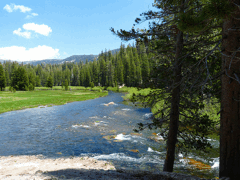River Resurrection
Air Date: Week of October 2, 2009

Middle Fork of the San Joaquin River
The San Joaquin flows freely again after nearly half a century. But not everyone is welcoming the river revival. Farmers are nervous there won’t be enough water for all their crops.
Transcript
YOUNG: California’s second-longest river, the San Joaquin, once flowed from the Sierra Nevada through the fertile Central Valley to San Francisco Bay. But for the past 40 years, dams and diversions for farming caused long stretches to run dry. Now, new public lands’ legislation brought a small gush of water from Friant Dam, to the cheers of environmentalists. Monty Schmitt of the National Resources Defense Council believes this will help the people and the ecology of San Joaquin Valley, especially the Chinook salmon.
SCHMITT: Currently, over 60 miles of that river dry up, so in the future – in the very near future – we will have flows year-round, always connecting the river all the way to the sea. This is the second year that the commercial salmon fishery has been closed down, and while there’s a lot of reasons why the populations have been crashing, restoring the San Joaquin River is truly one of the best and most important things that can be done in the near term to help restore that fishery and to bring the commercial salmon industry back to health.

Middle Fork of the San Joaquin River (http://www.flickr.com/photos/california_dreamin_77/3903363711/)
CURWOOD: The River may be only a tiny trickle of water as of yet, but the legislation is making big waves in the agricultural community. Kole Upton says that farmers like him are used to adversity, but the loss of irrigation is a steep price for a project that given the threats from widespread sewage pollution and a warming climate may not even save the salmon….
UPTON: What we’re looking at in our area is probably 15 to 20 percent of the land will just go out of business in order to balance the water that we have with what we’re going to get. The politicians and the government agencies say, well, we just need more and more water from the valley to clean up the delta. They can take every drop from us here in the Central Valley and it’s not going to clean up that delta until they address the other issues that are causing the decline in the species. I mean, I applaud the effort -- right now, I’m just afraid that we’re going to spend a lot of money and run a lot of people out of business, and fail in the process.
Living on Earth wants to hear from you!
Living on Earth
62 Calef Highway, Suite 212
Lee, NH 03861
Telephone: 617-287-4121
E-mail: comments@loe.org
Newsletter [Click here]
Donate to Living on Earth!
Living on Earth is an independent media program and relies entirely on contributions from listeners and institutions supporting public service. Please donate now to preserve an independent environmental voice.
NewsletterLiving on Earth offers a weekly delivery of the show's rundown to your mailbox. Sign up for our newsletter today!
 Sailors For The Sea: Be the change you want to sea.
Sailors For The Sea: Be the change you want to sea.
 The Grantham Foundation for the Protection of the Environment: Committed to protecting and improving the health of the global environment.
The Grantham Foundation for the Protection of the Environment: Committed to protecting and improving the health of the global environment.
 Contribute to Living on Earth and receive, as our gift to you, an archival print of one of Mark Seth Lender's extraordinary wildlife photographs. Follow the link to see Mark's current collection of photographs.
Contribute to Living on Earth and receive, as our gift to you, an archival print of one of Mark Seth Lender's extraordinary wildlife photographs. Follow the link to see Mark's current collection of photographs.
 Buy a signed copy of Mark Seth Lender's book Smeagull the Seagull & support Living on Earth
Buy a signed copy of Mark Seth Lender's book Smeagull the Seagull & support Living on Earth

